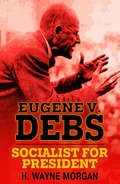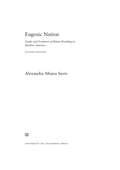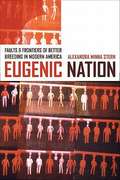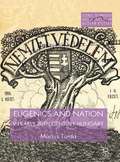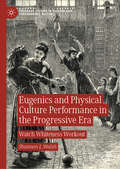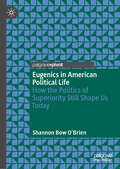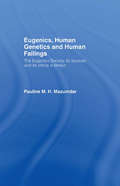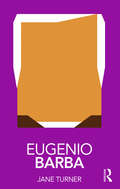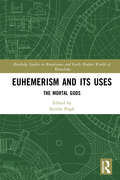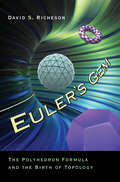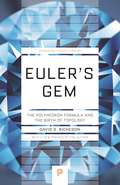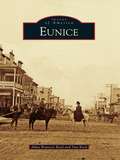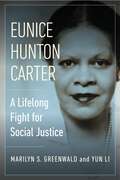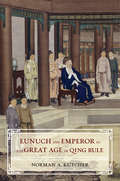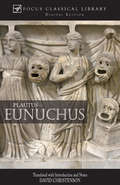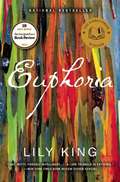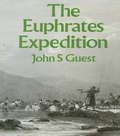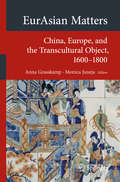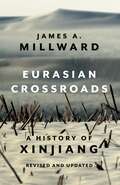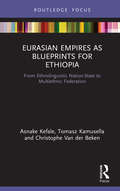- Table View
- List View
Eugene V. Debs: Socialist for President
by H. Wayne MorganEugene V. Debs: Socialist for President, first published in 1962, is a fascinating account of the heady days of American socialism in the early 1900s, the five campaigns of its dogged leader Eugene Debs, and the struggles of the labor movement. Included are 8 pages of illustrations.
Eugenic Nation
by Alexandra Minna SternFirst edition, Winner of the Arthur J. Viseltear Prize, American Public Health Association With an emphasis on the American West, Eugenic Nation explores the long and unsettled history of eugenics in the United States. This expanded second edition includes shocking details demonstrating that eugenics continues to inform institutional and reproductive injustice. Alexandra Minna Stern draws on recently uncovered historical records to reveal patterns of racial bias in California's sterilization program and documents compelling individual experiences. With the addition of radically new and relevant research, this edition connects the eugenic past to the genomic present with attention to the ethical and social implications of emerging genetic technologies.
Eugenic Nation: Faults and Frontiers of Better Breeding in Modern America
by Alexandra Minna SternMany people assume that eugenics all but disappeared with the fall of Nazism, but as this sweeping history demonstrates, the idea of better breeding had a wide and surprising reach in the United States throughout the twentieth century. With an original emphasis on the American West, Eugenic Nation brings to light many little-known facts--for example, that one-third of the involuntary sterilizations in this country occurred in California between 1909 and 1979--as it explores the influence of eugenics on phenomena as varied as race-based intelligence tests, school segregation, tropical medicine, the Border Patrol, and the environmental movement. Eugenic Nation begins in the 1900s, when influential California eugenicists molded an extensive agenda of better breeding for the rest of the country. The book traces hereditarian theories of sex and gender to the culture of conformity of the 1950s and moves to the 1960s, arguing that the liberation movements of that decade emerged in part as a challenge to policies and practices informed by eugenics.
Eugenics and Nation in Early 20th Century Hungary
by Marius TurdaIn 1900 Hungary was a regional power in Europe with imperial pretensions; by 1919 it was crippled by profound territorial, social and national transformations. This book chronicles the development of eugenic thinking in early twentieth-century Hungary, examining how eugenics was an integral part of this dynamic historical transformation.
Eugenics and Physical Culture Performance in the Progressive Era: Watch Whiteness Workout (Palgrave Studies in Theatre and Performance History)
by Shannon L. WalshThis book strives to unmask the racial inequity at the root of the emergence of modern physical culture systems in the US Progressive Era (1890s–1920s). This book focuses on physical culture – systematic, non-competitive exercise performed under the direction of an expert – because tracing how people practiced physical culture in the Progressive Era, especially middle- and upper-class white women, reveals how modes of popular performance, institutional regulation, and ideologies of individualism and motherhood combined to sublimate whiteness beneath the veneer of liberal progressivism and reform. The sites in this book give the fullest picture of the different strata of physical culture for white women during that time and demonstrate the unracialization of whiteness through physical culture practices. By illuminating the ways in which whiteness in the US became a default identity category absorbed into the “universal” ideals of culture, arts, and sciences, the author shows how physical culture circulated as a popular performance form with its own conventions, audience, and promised profitability. Finally, the chapters reveal troubling connections between the daily habits physical culturists promoted and the eugenics movement’s drive towards more reproductively efficient white bodies. By examining these written, visual, and embodied texts, the author insists on a closer scrutiny of the implicit whiteness of physical culture and forwards it as a crucial site of analysis for performance scholars interested in how corporeality is marshaled by and able to contest local and global systems of power.
Eugenics in American Political Life: How the Politics of Superiority Still Shape Us Today
by Shannon Bow O'BrienThe book explores the development of the American eugenics movement and how it still plays a role in American life. Building on a brief overview of the concept of eugenics, Shannon Bow O’Brien charts the foundations of the ideas, significant influences, and influencers of the movement in the last 19th and early 20th centuries. She discusses how these ideals and social life shaped American culture and encouraged attitudes toward racial and ethnic biases, including immigration policies in that period. O’Brien examines how the founding of the United States of America was built on unwanted individuals from the United Kingdom; transported felons and indentured servants were many of the original colonists. As the population forged its new nation, many of these individuals were the focus of restrictive immigration policies that sought to amend the identity of the American citizen and sought to define acceptable roles for Black persons within American society. Faithful slave monuments provided physical models to help engrain these roles within American life. O’Brien traces the development of the Mammy statue movement and its intersectionality with the restrictive immigration laws. Finally, she turns to the rhetoric of Donald Trump and contextualizes his speech in the ideology of the superiority of White Nordic nativism within American life.
Eugenics, 'Aristogenics', Photography: Picturing Privilege
by Kris Belden-AdamsThis is the first study to explore the connections between late-19th-century university/college composite class portraits and the field of eugenics – which first took hold in the United States at Harvard University. Eugenics, "Aristogenics," Photography takes a closer look at how composite portraiture documented an idealized “reality” of the New England social-caste experience and explains how, when positioned in relation to the individual stories and portraits of members of the class, the portraits reveal points of non-conformity and rebellion with their own rhetoric.
Eugenics, Human Genetics and Human Failings: The Eugenics Society, its sources and its critics in Britain
by Pauline MazumdarThis scholarly and penetrating study of eugenics is a major contribution to our understanding of the complex relation between science, ideology and class.
Eugenio Barba (Routledge Performance Practitioners)
by Jane TurnerEugenio Barba is recognized as one of the most important theatre practitioners working today. Along with the company he founded over fifty years ago, the world-acclaimed Odin Teatret, he continues to produce extraordinary theatre performances that tour the world, and his International School of Theatre Anthropology has greatly developed research into the craft of the actor. Now revised and updated, this volume reveals the background to and work of a major influence on twentieth- and twenty-first century performance. Eugenio Barba is the first book to combine: an overview of Barba’s work and that of his company, Odin Teatret exploration of his writings and ideas on theatre anthropology, and his unique contribution to contemporary performance research in-depth analysis of the 2000 production of Ego Faust, performed at the International School of Theatre Anthropology a practical guide to training exercises developed by Barba and the actors in the company. As a first step towards critical understanding, and as an initial exploration before going on to further, primary research, Routledge Performance Practitioners offer unbeatable value for today’s student.
Euhemerism and Its Uses: The Mortal Gods (Routledge Studies in Renaissance and Early Modern Worlds of Knowledge)
by Syrithe PughEuhemerism and Its Uses offers the first interdisciplinary, focussed, and all-round view of the long history of an important but understudied phenomenon in European intellectual and cultural history. Euhemerism – the claim that the Greek gods were historically mortal men and women – originated in the early third century BCE, in an enigmatic and now fragmentary text by the otherwise unknown author Euhemeros. This work, the Sacred Inscription, has been read variously as a theory of religion, an atheist’s manifesto, as justifying or satirizing ruler-worship, as a fantasy travel-narrative, and as an early ‘utopia’. Influencing Hellenistic and Roman literature and religious and political thought, and appropriated by early Christians to debunk polytheism while simultaneously justifying the continued study of classical literature, euhemerism was widespread in the middle ages and Renaissance, and its reverberations continue to be felt in modern myth-theory. Yet, though frequently invoked as a powerful and pervasive tradition across several disciplines, it is still under-examined and poorly understood. Filling an important gap in the history of ideas, this volume will appeal to scholars and students of classical reception, mediaeval and Renaissance literature, historiography, and theories of myth and religion.
Euler's Gem
by David S. RichesonLeonhard Euler's polyhedron formula describes the structure of many objects--from soccer balls and gemstones to Buckminster Fuller's buildings and giant all-carbon molecules. Yet Euler's formula is so simple it can be explained to a child. Euler's Gem tells the illuminating story of this indispensable mathematical idea. From ancient Greek geometry to today's cutting-edge research, Euler's Gem celebrates the discovery of Euler's beloved polyhedron formula and its far-reaching impact on topology, the study of shapes. In 1750, Euler observed that any polyhedron composed of V vertices, E edges, and F faces satisfies the equation V-E+F=2. David Richeson tells how the Greeks missed the formula entirely; how Descartes almost discovered it but fell short; how nineteenth-century mathematicians widened the formula's scope in ways that Euler never envisioned by adapting it for use with doughnut shapes, smooth surfaces, and higher dimensional shapes; and how twentieth-century mathematicians discovered that every shape has its own Euler's formula. Using wonderful examples and numerous illustrations, Richeson presents the formula's many elegant and unexpected applications, such as showing why there is always some windless spot on earth, how to measure the acreage of a tree farm by counting trees, and how many crayons are needed to color any map. Filled with a who's who of brilliant mathematicians who questioned, refined, and contributed to a remarkable theorem's development, Euler's Gem will fascinate every mathematics enthusiast.
Euler's Gem: The Polyhedron Formula and the Birth of Topology
by David S. RichesonHow a simple equation reshaped mathematicsLeonhard Euler’s polyhedron formula describes the structure of many objects—from soccer balls and gemstones to Buckminster Fuller’s buildings and giant all-carbon molecules. Yet Euler’s theorem is so simple it can be explained to a child. From ancient Greek geometry to today’s cutting-edge research, Euler’s Gem celebrates the discovery of Euler’s beloved polyhedron formula and its far-reaching impact on topology, the study of shapes. Using wonderful examples and numerous illustrations, David Richeson presents this mathematical idea’s many elegant and unexpected applications, such as showing why there is always some windless spot on earth, how to measure the acreage of a tree farm by counting trees, and how many crayons are needed to color any map. Filled with a who’s who of brilliant mathematicians who questioned, refined, and contributed to a remarkable theorem’s development, Euler’s Gem will fascinate every mathematics enthusiast. This paperback edition contains a new preface by the author.
Eunice
by Van Rodney Reed Alma Brunson ReedBeginning as a real estate venture on the isolated prairie of southwestern Louisiana in 1894, Eunice is now a progressive small city due to its traditions of volunteerism, community spirit, and resourcefulness. In the late 1980s, the city enjoyed a renaissance when a far-sighted mayor capitalized on the dominant Cajun culture to pull Eunice out of the economic crevasse of the decade's "oil bust." It emerged as a picturesque community with an emphasis on its rich history and its newly recognized heritage tourism. The city's unique Frenchness lures tourists and locals to the live Cajun music shows at the Liberty Center and to experience the joie de vivre at a rural Mardi Gras. The historic images found in Images of America: Eunice feature the day-to-day activities of Eunice's people through good times and lean days from 1894 to the late 1980s.
Eunice Hunton Carter: A Lifelong Fight for Social Justice
by Yun Li Marilyn Greenwald2022 PROSE Awards Category Winner - Biography & AutobiographyForeword INDIES Book of the Year Awards - 2021 BRONZE Winner for BiographyThe fascinating biography of Eunice Hunton Carter, a social justice and civil rights trailblazer and the only woman prosecutor on the Luciano trial Eunice Hunton Carter rose to public prominence in 1936 as both the only woman and the only person of color on Thomas Dewey’s famous gangbuster team that prosecuted mobster Lucky Luciano. But her life before and after the trial remains relatively unknown. In this definitive biography on this trailblazing social justice activist, authors Marilyn S. Greenwald and Yun Li tell the story of this unknown but critical pioneer in the struggle for racial and gender equality in the twentieth century.Carter worked harder than most men because of her race and gender, and Greenwald and Li reflect on her lifelong commitment to her adopted home of Harlem, where she was viewed as a role model, arts patron, community organizer, and, later, as a legal advisor to the United Nations, the National Council of Negro Women, and several other national and global organizations.Carter was both a witness to and a participant in many pivotal events of the early and mid– twentieth century, including the Harlem riot of 1935 and the social scene during the Harlem Renaissance.Using transcripts, letters, and other primary and secondary sources from several archives in the United States and Canada, the authors paint a colorful portrait of how Eunice continued the legacy of the Carter family, which valued education, perseverance, and hard work: a grandfather who was a slave who bought his freedom and became a successful businessman in a small colony of former slaves in Ontario, Canada; a father who nearly single-handedly integrated the nation’s YMCAs in the Jim Crow South; and a mother who provided aid to Black soldiers in France during World War I and who became a leader in several global and domestic racial equality causes.Carter’s inspirational multi-decade career working in an environment of bias, segregation, and patriarchy in Depression-era America helped pave the way for those who came after her.
Eunuch and Emperor in the Great Age of Qing Rule
by Norman A. KutcherEunuch and Emperor in the Great Age of Qing Rule offers a new interpretation of eunuchs and their connection to imperial rule in the first century and a half of the Qing dynasty (1644–1800). This period encompassed the reigns of three of China’s most important emperors, men who were deeply affected by the great eunuch corruption of the fallen Ming dynasty. In this groundbreaking and deeply researched book, the author explores how Qing emperors sought to prevent a return of the harmful excesses of eunuchs and how eunuchs flourished in the face of the restrictions imposed upon them. We meet powerful eunuchs who faithfully served, and in some cases ultimately betrayed, their emperors. We also meet ordinary eunuchs whose lives, punctuated by dramas large and small, provide a fascinating perspective on the Qing palace world.
Eunuchus: The Eunuch
by Terence David ChristensonThe play Eunuchus provides an introduction to the world of Roman comedy from one of its best practitioners, Terence. As with all Focus translations, the emphasis is on an inexpensive, readable edition that is close to the original, with an extensive introduction, notes and appendices.
Euphoria
by Lily KingOne of New York Times Best 10 Books for 2014. <P> From New England Book Award winner Lily King comes a breathtaking novel about three young anthropologists of the ‘30’s caught in a passionate love triangle that threatens their bonds, their careers, and, ultimately, their lives.<P> English anthropologist Andrew Bankson has been alone in the field for several years, studying the Kiona river tribe in the Territory of New Guinea. Haunted by the memory of his brothers’ deaths and increasingly frustrated and isolated by his research, Bankson is on the verge of suicide when a chance encounter with colleagues, the controversial Nell Stone and her wry and mercurial Australian husband Fen, pulls him back from the brink. Nell and Fen have just fled the bloodthirsty Mumbanyo and, in spite of Nell’s poor health, are hungry for a new discovery. When Bankson finds them a new tribe nearby, the artistic, female-dominated Tam, he ignites an intellectual and romantic firestorm between the three of them that burns out of anyone’s control.<P> Set between two World Wars and inspired by events in the life of revolutionary anthropologist Margaret Mead, Euphoria is an enthralling story of passion, possession, exploration, and sacrifice from accomplished author Lily King.
Euphrates Expedition
by John. S. GuestFirst published in 1992. This book invites the reader to cast the mind a hundred and fifty years back to a short span of time between 1829 and 1842. This was an exciting period when Britain’s might, demonstrated to the world at Trafalgar and Waterloo, was fortified by leadership in steam technology and was given a new direction by the liberal philosophy that British statesmen, thinkers and poets proclaimed at home and abroad. The Euphrates expedition was an attempt by well-intentioned British governments to achieve a geopolitical end by a technological means. The objective was to halt Russian expansion in the Near East, where some observers saw a threat to Britain’s control of India.
EurAsian Matters: China, Europe, And The Transcultural Object, 1600-1800 (Transcultural Research – Heidelberg Studies on Asia and Europe in a Global Context)
by Monica Juneja Anna GrasskampThe volume examines the mutually constitutive relationship between the materiality of objects and their aesthetic meanings. Its approach connects material culture with art history, curation, technologies and practices of making. A central dimension of the case studies collected here is the mobility of objects between Europe and China and the transformations that unfold as a result of their transcultural lives. Many of the objects studied here are relatively unknown or understudied. The stories they recount suggest new ways of thinking about space, cultural geographies and the complex and often contradictory association of power and culture. These studies of transcultural objects can suggest pathways for museum experts by uncovering the multi-layered identities and temporalities of objects that can no longer be labelled as located in single regions. It is also addressed to students of art history, of European and Chinese studies and scholars of consumer culture.« This eagerly awaited volume offers deep and extensive insights into the fast-growing field of material culture studies. Its fresh approach to Eurasian objects and materialities will serve as useful reading for all scholars interested in transcultural and global studies. A very helpful introductory essay. » Sabine du Crest, University of Bordeaux Montaigne, Former Fellow, The Harvard University Center for Italian Renaissance Studies.
Eurasia
by Christopher EvansIn "Eurasia" the author describes an ideal republic where many of the problems that confront us are worked out. The book describes in an interesting and readable way how government is administered in this ideal republic. The government is one in which women take their full share of responsibility, the school children are trained in the problems they will meet in life, and more emphasis is laid on character building than on the dead languages. The children of both sexes are taught useful trades. All school children are taught to swim. The idle are employed in the construction of roads, canals and irrigation works. The problems of distribution are so arranged that the worker receives a more equitable reward for his labor.
Eurasia at the Dawn of History
by Fernández-Götz Manuel Dirk KrausseOur current world is characterized by life in cities, the existence of social inequalities, and increasing individualization. When and how did these phenomena arise? What was the social and economic background for the development of hierarchies and the first cities? The authors of this volume analyze the processes of centralization, cultural interaction, and social differentiation that led to the development of the first urban centres and early state formations of ancient Eurasia, from the Atlantic coasts to China. The chronological framework spans a period from the Neolithic to the Late Iron Age, with a special focus on the early first millennium BC. By adopting an interdisciplinary approach structured around the concepts of identity and materiality, this book addresses the appearance of a range of key phenomena that continue to shape our world.
Eurasian
by Emma Jinhua TengIn the second half of the nineteenth century, global labor migration, trade, and overseas study brought China and the United States into close contact, leading to new cross-cultural encounters that brought mixed-race families into being. Yet the stories of these families remain largely unknown. How did interracial families negotiate their identities within these societies when mixed-race marriage was taboo and "Eurasian" often a derisive term? In Eurasian, Emma Jinhua Teng compares Chinese-Western mixed-race families in the United States, China, and Hong Kong, examining both the range of ideas that shaped the formation of Eurasian identities in these diverse contexts and the claims set forth by individual Eurasians concerning their own identities. Teng argues that Eurasians were not universally marginalized during this era, as is often asserted. Rather, Eurasians often found themselves facing contradictions between exclusionary and inclusive ideologies of race and nationality, and between overt racism and more subtle forms of prejudice that were counterbalanced by partial acceptance and privilege.By tracing the stories of mixed and transnational families during an earlier era of globalization, Eurasian also demonstrates to students, faculty, scholars, and researchers how changes in interracial ideology have allowed the descendants of some of these families to reclaim their dual heritage with pride.
Eurasian Crossroads: A History of Xinjiang, Revised and Updated
by James MillwardSince antiquity, the vast Central Eurasian region of Xinjiang, or Eastern Turkestan, has stood at the crossroads of China, India, the Middle East, and Europe, playing a pivotal role in the social, cultural, and political histories of Asia and the world. Today, it comprises one-sixth of the territory of the People’s Republic of China and borders India, Pakistan, Afghanistan, Tajikistan, Kyrgyzstan, Kazakhstan, Russia, and Mongolia.Eurasian Crossroads is an engaging and comprehensive account of Xinjiang’s history and people from earliest times to the present day. Drawing on primary sources in several Asian and European languages, James A. Millward surveys Xinjiang’s rich environmental and cultural heritage as well as its historical and contemporary geopolitical significance. Xinjiang was once the hub of the Silk Road and the conduit through which Buddhism, Christianity, and Islam entered China. It was also a fulcrum where Sinic, steppe nomadic, Tibetan, and Islamic imperial realms engaged and struggled. In the twentieth and twenty-first centuries, the Han-dominated Chinese Communist Party has failed to include Xinjiang’s diverse indigenous Central Asian peoples. Its nationalistic visions have spurred domestic troubles that now affect the PRC’s foreign affairs and global ambitions.This revised and updated edition features new empirically grounded and balanced analysis of the latest developments in the region, focusing on the circumstances of the Uyghurs, Kazakhs, and other Xinjiang peoples in the face of policies implemented by the Chinese Communist Party.
Eurasian Empires as Blueprints for Ethiopia: From Ethnolinguistic Nation-State to Multiethnic Federation (Routledge Studies in Modern History)
by Tomasz Kamusella Asnake Kefale Christophe Van der BekenThis book is a contribution to the global history of the transfer of political ideas, as exemplified by the case of modern Ethiopia. Like many non-European nation-states, Ethiopia adopted a western model of statehood, that is, the nation-state. Unlike the postcolonial polities that have retained the mode of statehood imposed on them by their colonial powers, Ethiopia was never successfully colonized leaving its ruling elite free to select a model of ‘modern’ (western) statehood. In 1931, via Japan, they adopted the model of unitary, ethnolinguistically homogenous nation-state, in turn copied by Tokyo in 1889 from the German Empire (founded in 1871). Following the Ethiopian Revolution (1974) that overthrew the imperial system, the new revolutionary elite promised to address the ‘nationality question’ through the marxist-leninist model. The Soviet model of ethnolinguistic federalism (originally derived from Austria-Hungary) was introduced in Ethiopia, first in 1992 and officially with the 1995 Constitution. To this day the politics of modern Ethiopia is marked by the tension between these two opposed models of the essentially central European type of statehood. The late 19th-century ‘German-German’ quarrel on the ‘proper’ model of national statehood for Germany – or more broadly, modern central Europe – remains the quarrel of Ethiopian politics nowadays. The book will be useful for scholars of Ethiopian and African history and politics, and also offers a case in comparative studies on the subject of different models of national statehood elsewhere.
Eurasian Empires in Antiquity and the Early Middle Ages: Contact and Exchange between the Graeco-Roman World, Inner Asia and China
by Kim Hyun Jin Vervaet Frederik Juliaan Adalı Selim FerruhThe great empires of the vast Eurasian continent have captured the imagination of many. Awe-inspiring names such as ancient Rome, Han and Tang China, Persia, Assyria, the Huns, the Kushans and the Franks have been the subject of countless scholarly books and works of literature. However, very rarely, if at all, have these vast pre-industrial empires been studied holistically from a comparative, interdisciplinary and above all Eurasian perspective. This collection of studies examines the history, literature and archaeology of these empires and others thus far treated separately as a single inter-connected subject of inquiry. It highlights in particular the critical role of Inner Asian empires and peoples in facilitating contacts and exchange across the Eurasian continent in antiquity and the early Middle Ages.
